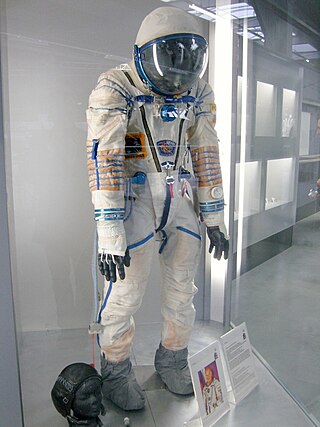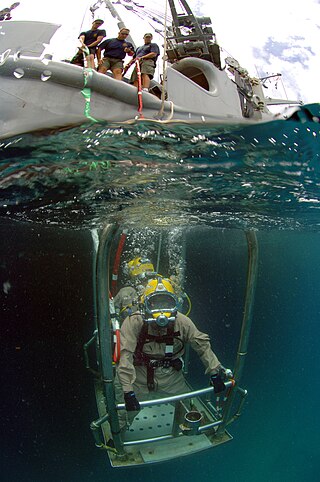
A space suit or spacesuit is a garment worn to keep a human alive in the harsh environment of outer space, vacuum and temperature extremes. Space suits are often worn inside spacecraft as a safety precaution in case of loss of cabin pressure, and are necessary for extravehicular activity (EVA), work done outside spacecraft. Space suits have been worn for such work in Earth orbit, on the surface of the Moon, and en route back to Earth from the Moon. Modern space suits augment the basic pressure garment with a complex system of equipment and environmental systems designed to keep the wearer comfortable, and to minimize the effort required to bend the limbs, resisting a soft pressure garment's natural tendency to stiffen against the vacuum. A self-contained oxygen supply and environmental control system is frequently employed to allow complete freedom of movement, independent of the spacecraft.

Personal protective equipment (PPE) is protective clothing, helmets, goggles, or other garments or equipment designed to protect the wearer's body from injury or infection. The hazards addressed by protective equipment include physical, electrical, heat, chemicals, biohazards, and airborne particulate matter. Protective equipment may be worn for job-related occupational safety and health purposes, as well as for sports and other recreational activities. Protective clothing is applied to traditional categories of clothing, and protective gear applies to items such as pads, guards, shields, or masks, and others. PPE suits can be similar in appearance to a cleanroom suit.

An airlock is a compartment which permits passage between environments of differing atmospheric pressure or composition while minimizing the mixing of environments or change in pressure in the adjoining spaces. "Airlock" is sometimes written as air-lock or air lock, or abbreviated to just lock.
An underwater environment is a environment of, and immersed in, liquid water in a natural or artificial feature, such as an ocean, sea, lake, pond, reservoir, river, canal, or aquifer. Some characteristics of the underwater environment are universal, but many depend on the local situation.

A diving suit is a garment or device designed to protect a diver from the underwater environment. A diving suit may also incorporate a breathing gas supply, but in most cases the term applies only to the environmental protective covering worn by the diver. The breathing gas supply is usually referred to separately. There is no generic term for the combination of suit and breathing apparatus alone. It is generally referred to as diving equipment or dive gear along with any other equipment necessary for the dive.
Diving physics, or the physics of underwater diving is the basic aspects of physics which describe the effects of the underwater environment on the underwater diver and their equipment, and the effects of blending, compressing, and storing breathing gas mixtures, and supplying them for use at ambient pressure. These effects are mostly consequences of immersion in water, the hydrostatic pressure of depth and the effects of pressure and temperature on breathing gases. An understanding of the physics is useful when considering the physiological effects of diving, breathing gas planning and management, diver buoyancy control and trim, and the hazards and risks of diving.

A mechanical counterpressure (MCP) suit, partial pressure suit, direct compression suit, or space activity suit (SAS) is an experimental spacesuit which applies stable pressure against the skin by means of skintight elastic garments. The SAS is not inflated like a conventional spacesuit: it uses mechanical pressure, rather than air pressure, to compress the human body in low-pressure environments. Development was begun by NASA and the Air Force in the late 1950s and then again in the late 1960s, but neither design was used. Research is under way at the Massachusetts Institute of Technology (MIT) on a "Bio-Suit" System which is based on the original SAS concept.
Dysbarism refers to medical conditions resulting from changes in ambient pressure. Various activities are associated with pressure changes. Underwater diving is the most frequently cited example, but pressure changes also affect people who work in other pressurized environments, and people who move between different altitudes.

A breathing apparatus or breathing set is equipment which allows a person to breathe in a hostile environment where breathing would otherwise be impossible, difficult, harmful, or hazardous, or assists a person to breathe. A respirator, medical ventilator, or resuscitator may also be considered to be breathing apparatus. Equipment that supplies or recycles breathing gas other than ambient air in a space used by several people is usually referred to as being part of a life-support system, and a life-support system for one person may include breathing apparatus, when the breathing gas is specifically supplied to the user rather than to the enclosure in which the user is the occupant.

A pressure suit is a protective suit worn by high-altitude pilots who may fly at altitudes where the air pressure is too low for an unprotected person to survive, even breathing pure oxygen at positive pressure. Such suits may be either full-pressure or partial-pressure. Partial-pressure suits work by providing mechanical counter-pressure to assist breathing at altitude.
Diving disorders, or diving related medical conditions, are conditions associated with underwater diving, and include both conditions unique to underwater diving, and those that also occur during other activities. This second group further divides into conditions caused by exposure to ambient pressures significantly different from surface atmospheric pressure, and a range of conditions caused by general environment and equipment associated with diving activities.

The Sokol space suit, also known as the Sokol IVA suit or simply the Sokol, is a type of Soviet/Russian space suit, worn by all who fly on the Soyuz spacecraft. It was introduced in 1973 and is still used as of 2023. The Sokol is described by its makers as a rescue suit and it is not capable of being used outside the spacecraft in a spacewalk or extravehicular activity. Instead, its purpose is to keep the wearer alive in the event of an accidental depressurisation of the spacecraft. In this respect, it is similar to the ACES suit that was worn aboard NASA's Space Shuttle during launch and landing.

Underwater diving, as a human activity, is the practice of descending below the water's surface to interact with the environment. It is also often referred to as diving, an ambiguous term with several possible meanings, depending on context. Immersion in water and exposure to high ambient pressure have physiological effects that limit the depths and duration possible in ambient pressure diving. Humans are not physiologically and anatomically well-adapted to the environmental conditions of diving, and various equipment has been developed to extend the depth and duration of human dives, and allow different types of work to be done.
Ebullism is the formation of water vapour bubbles in bodily fluids due to reduced environmental pressure, usually at extreme high altitude. It occurs because a system of liquid and gas at equilibrium will see a net conversion of liquid to gas as pressure lowers; for example, liquids reach their boiling points at lower temperatures when the pressure on them is lowered. The injuries and disorder caused by ebullism is also known as ebullism syndrome. Ebullism will expand the volume of the tissues, but the vapour pressure of water at temperatures in which a human can survive is not sufficient to rupture skin or most other tissues encased in skin. Ebullism produces predictable injuries, which may be survivable if treated soon enough, and is often accompanied by complications caused by rapid decompression, such as decompression sickness and a variety of barotrauma injuries. Persons at risk are astronauts and high altitude aviators, for whom it is an occupational hazard.

A liquid cooling garment (LCG) is a form-fitting garment that is used to remove body heat from the wearer in environments where evaporative cooling from sweating and open-air convection cooling does not work or is insufficient, or the wearer has a biological problem that hinders self-regulation of body temperature.

Science fiction authors have designed imaginary spacesuits for their characters almost since the beginning of fiction set in space.

Hazmat diving is underwater diving in a known hazardous materials environment. The environment may be contaminated by hazardous materials, the diving medium may be inherently a hazardous material, or the environment in which the diving medium is situated may include hazardous materials with a significant risk of exposure to these materials to members of the diving team. Special precautions, equipment and procedures are associated with hazmat diving so that the risk can be reduced to an acceptable level.
Diving hazards are the agents or situations that pose a threat to the underwater diver or their equipment. Divers operate in an environment for which the human body is not well suited. They face special physical and health risks when they go underwater or use high pressure breathing gas. The consequences of diving incidents range from merely annoying to rapidly fatal, and the result often depends on the equipment, skill, response and fitness of the diver and diving team. The classes of hazards include the aquatic environment, the use of breathing equipment in an underwater environment, exposure to a pressurised environment and pressure changes, particularly pressure changes during descent and ascent, and breathing gases at high ambient pressure. Diving equipment other than breathing apparatus is usually reliable, but has been known to fail, and loss of buoyancy control or thermal protection can be a major burden which may lead to more serious problems. There are also hazards of the specific diving environment, and hazards related to access to and egress from the water, which vary from place to place, and may also vary with time. Hazards inherent in the diver include pre-existing physiological and psychological conditions and the personal behaviour and competence of the individual. For those pursuing other activities while diving, there are additional hazards of task loading, of the dive task and of special equipment associated with the task.

A Mars suit or Mars space suit is a space suit for EVAs on the planet Mars. Compared to a suit designed for space-walking in the near vacuum of low Earth orbit, Mars suits have a greater focus on actual walking and a need for abrasion resistance. Mars' surface gravity is 37.8% of Earth's, approximately 2.3 times that of the Moon, so weight is a significant concern, but there are fewer thermal demands compared to open space. At the surface the suits would contend with the atmosphere of Mars, which has a pressure of about 0.6 to 1 kilopascal. On the surface, radiation exposure is a concern, especially solar flare events, which can dramatically increase the amount of radiation over a short time.
An exposure suit, or anti-exposure suit, is clothing intended to protect the wearer from an extreme environment. Depending on the environment and specific use the suit may be required to provide thermal insulation, buoyancy, and or complete isolation from the environment. The exposure suit may be a stand-alone unit, or may require undergarments to function correctly. The choice of undergarments may depend on the specific environment. A common use of the term refers to protection from cold and wet environments at sea. Depending on type, they may be worn during normal work, in emergencies, or when exposed to unusual conditions.













